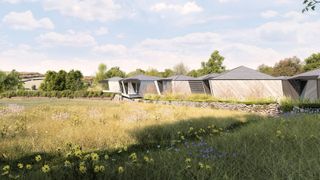Eco home with 'Cornish hedge' built into its design gets approval under Paragraph 80
Kea House was given planning approval by Cornwall Council as it was ruled the house would bring "significant biodiversity net gain" and "enhancement" to the local area

Plans for a home that incorporates a 'Cornish hedge' into its design have been approved under Paragraph 80 (e) planning laws.
Cornwall Council approved the plans for Merrymeeting Farm in Bodmin, which were put forward by Paul Sessions, an entrepreneur from Blisland.
The modern, single-storey, timber house was given planning approval underParagraph 80laws due to its "outstanding design" and the "significant biodiversity net gain" the home would bring to the area.
If you are looking to gain planning for your property under Paragraph 80 rules then this property could show you how.
What is Paragraph 80(e)?
"Paragraph 80" or "Para 80" is a specific criterion within the NPPF to allow for homebuilding in green belt areas.
Subsections 'a' through to 'd' deal with rural housing and the reuse of existing buildings. Paragraph 80 (e) is for new houses in green belt areas orconservation areaswhich fall outside of any of the previous conditions.
This provision allows for the construction of homes in rural areas, deviating from the general policies that restrict the development of new homes in such locations. Under section the NPPF (2021) it is statedplanning permissionmay be granted if:
- It is truly outstanding, reflecting the highest standards in architecture, and would help to raise standards of design more generally in rural areas; and...
- Would significantly enhance its immediate setting, and be sensitive to the defining characteristics of the local area.
'Cornish hedge' gives home a 'conceal and unveil' concept to blend it into the natural landscape
Kea House was presented as a Paragraph 80 (e) house and designed with a "landscape-driven" design so as not to disrupt or affect the look of the local area.
The architects for the project areSquirrel Designwho took inspiration from the Cornish countryside and historic field patterns in order to gain approval for planning permission, as the site was not only on green belt land, but also an Area of Greater Landscape Value (AGLV).
Environmental considerations were also at the forefront of the design as biophilic principles, and passive systems, including solar shading, solar panels and an air source heat pump, were also put forward to result in a design proposal that has nature and eco-friendly features at its core.
A Cornish hedge, which is normally built with stone found in Cornwall and sometimes are topped with hedging plants or trees, stands as a pivotal element within the design. This serves to give the home a "conceal and unveil" concept that is meant to "establish a connection" to the surrounding environment and also provide habitats for wildlife to live in.

Surrounding meadow and wetland rich in wildlife
The proposed landscaping for the home included 350m of Cornish hedges, 1ha of species-rich meadow and 0.7ha of wetland adopts an appropriately informal approach, which was deemed "sympathetic to this part of rural Cornwall" and the AGLV landscape in particular.
Alex O'Connor of Squirrel Design said: "The client for Kea House approached Squirrel Design with ambitions of building on a piece of land that nestled within an Area of Greater Landscape Value and is adjacent to the Bodmin Area of Outstanding Natural Beauty.
"Paragraph 80 (e) sets the requirements for design at a very high level for dwellings to be built in the open countryside. Initial scoping exercises with the design team deemed Paragraph 80 (e) was the most appropriate approach."

Eco home approved due to 'biodiversity net gain'
Cornwall Council granted planning permission for the Kea House due to its "outstanding design" and the "significant biodiversity net gain" of the house.
Approval was eventually given afterplanning permission was initially refuseddue to the Council’s objections to the effect of the development on the site and its landscape setting, and the fact the plot lies within an AGLV and also had limited accessibility to services without relying on "travel by private vehicles".
However, it was decided that the external materials used and low profile, design quality and backdrop of mature trees in the plans "would harmonise with the pleasing rural landscape of the AGLV".

Planning Inspector Martin Andrews stated in theplanning report: "My interpretation of the policy therefore is that it is the combination of the building’s outstanding design with its altered immediate setting in the form of a garden or appropriate landscaping within the curtilage that would result in an outcome that could be properly regarded as enhancement."
In addition it was ruled the scheme would achieve a "significant biodiversity net gain" for the area and the revised designs for the driveway also played an important part in amending the proposal since the dismissed appeal.
It was ultimately ruled that the dwelling with the proposed landscaping and ecological enhancements would "be sensitive to the defining characteristics of the local area" as required in Paragraph 80(e), and so planning approval was given.
This is therefore anotherhome that managed to beat countryside planning ruleswith work expected to begin later this year.

Get the Homebuilding & Renovating Newsletter
Bring your dream home to life with expert advice, how-to guides and design inspiration, direct to your inbox.

News Editor Joseph has previously written for Today’s Media and Chambers & Partners, focusing on news for conveyancers and industry professionals. Joseph has just started his own self build project, building his own home on his family’s farm with planning permission for a timber frame, three-bedroom house in a one-acre field. The foundation work has already begun and he hopes to have the home built in the next year. Prior to this he renovated his family's home as well as doing several DIY projects, including installing a shower, building sheds, and livestock fences and shelters for the farm’s animals. Outside of homebuilding, Joseph loves rugby and has written for Rugby World, the world’s largest rugby magazine.
Bring your dream home to life with expert advice, how-to guides and design inspiration, direct to your inbox.
Thank you for signing up to Homebuilding. You will receive a verification email shortly.
There was a problem. Please refresh the page and try again.
